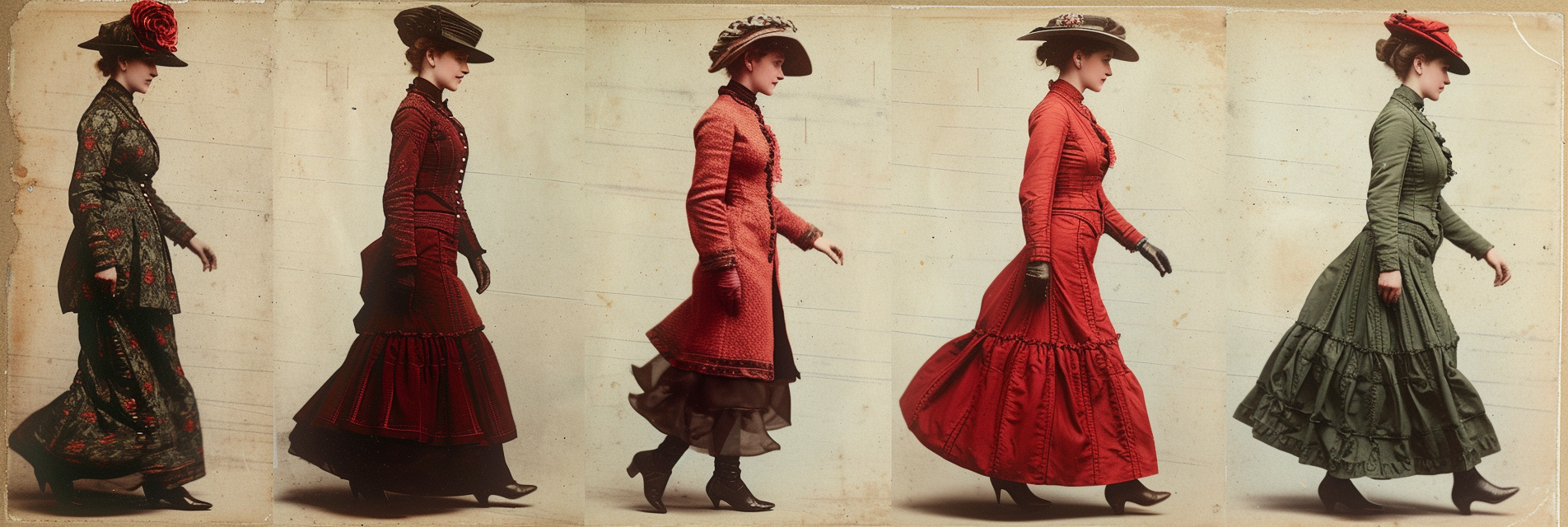A Century of Elegance: The Evolution of Women's Fashion Over the Last 100 Years
4 min readThe journey of women's fashion over the past century has been a remarkable tapestry of changing styles, social shifts, and a reflection of the evolving roles of women in society. From the Roaring Twenties to the digital age, each decade has contributed to the rich and diverse landscape of women's fashion. Let's explore the transformative trends that have shaped the past century, celebrating the resilience, creativity, and empowerment expressed through the ever-changing world of style.

1920s: The Roaring Twenties and the Flapper Revolution
The 1920s ushered in a radical departure from the corseted silhouettes of the previous decades. The flapper style emerged as a symbol of rebellion, with drop-waist dresses, shorter hemlines, and a liberating sense of movement. The iconic bobbed hairstyle and cloche hats became synonymous with the modern, independent woman of the Jazz Age.
1930s: The Glamour of Hollywood and the Influence of Art Deco
Despite the challenges of the Great Depression, the 1930s witnessed the rise of Hollywood glamour. Bias-cut gowns, figure-flattering silhouettes, and the incorporation of Art Deco influences defined the era. The silver screen, with stars like Jean Harlow and Ginger Rogers, set the stage for sophisticated elegance.
1940s: Utility Chic and the Impact of World War II
The 1940s saw the influence of World War II on fashion. Utility chic became a necessity with rationing, leading to practical, tailored styles. The iconic 'Rosie the Riveter' look symbolized the strength and resilience of women during wartime. After the war, the New Look introduced by Christian Dior brought back full skirts and a return to femininity.
1950s: The Golden Age of Couture and the Rise of Teen Fashion
The 1950s marked a return to glamour with the Golden Age of Couture. Christian Dior's hourglass silhouette dominated, emphasizing small waists and full skirts. The decade also witnessed the rise of teen fashion with the emergence of youth culture. Poodle skirts, saddle shoes, and bobby socks became iconic symbols of teenage style.
1960s: The Swinging Sixties and the Influence of Youth Culture
The 1960s brought a seismic shift in fashion with the Swinging Sixties. Youth culture and rebellion against traditional norms led to the popularity of miniskirts, shift dresses, and geometric patterns. Style icons like Twiggy and the mod movement revolutionized fashion, embracing bold colors and experimental designs.
1970s: Bohemian Vibes and the Disco Era
The 1970s embraced a more relaxed, bohemian style. Bell-bottoms, maxi dresses, and floral prints dominated the fashion landscape. The disco era introduced glamorous jumpsuits, metallic fabrics, and platform shoes. Women's fashion became a canvas for self-expression, reflecting the cultural shifts of the time.
1980s: Power Dressing and Bold Statements
The 1980s were characterized by power dressing, marked by strong shoulders, oversized blazers, and bold accessories. The influence of pop culture, from music videos to blockbuster films, played a significant role. The emergence of fitness culture also led to the popularity of activewear and athleisure.
1990s: Minimalism and Grunge
The 1990s brought a departure from the extravagance of the '80s. Minimalism became a key theme, with simple silhouettes, neutral colors, and clean lines. On the other end of the spectrum, the grunge movement introduced a more rebellious style with flannel shirts, combat boots, and a laid-back attitude.
2000s: The Rise of Fast Fashion and Eclectic Trends
The 2000s witnessed the rise of fast fashion, with trends changing at an unprecedented pace. Influenced by pop stars and celebrities, styles ranged from low-rise jeans and crop tops to bohemian-chic and preppy aesthetics. The eclectic nature of fashion in the 2000s reflected a globalized and interconnected world.
2010s: Sustainability, Diversity, and Influencer Culture
The 2010s saw a growing emphasis on sustainability, diversity, and individual expression. Fast fashion faced scrutiny, leading to a rise in eco-friendly and ethical practices. Social media influencers became powerful voices, shaping trends and challenging traditional beauty standards. The fashion industry began to embrace inclusivity in size, race, and gender.
2020s: A Fusion of Nostalgia and Innovation
As we navigate the early years of the 2020s, fashion has become a fusion of nostalgia and innovation. Vintage styles are reimagined, and sustainability remains a driving force. The digital age has brought fashion closer to consumers, with online shopping, virtual fashion shows, and a continuous dialogue between designers and their audiences.
In conclusion, the evolution of women's fashion over the last 100 years reflects not only changes in style but also the broader societal shifts, cultural movements, and the ongoing quest for self-expression. Each decade has contributed to the diverse and dynamic tapestry of women's fashion, celebrating resilience, creativity, and the evolving roles of women in the world. As we move forward, the fashion landscape continues to be a canvas for individual stories, a reflection of the times, and a celebration of the ever-changing spirit of women's style.